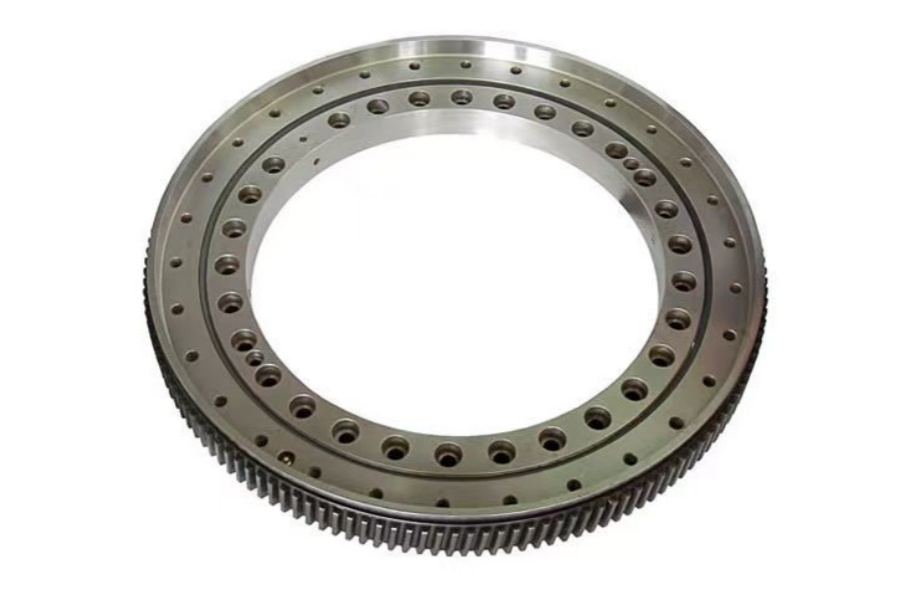2025 Trends in Slewing Bearing Technology: The Shift Toward Smart and Lightweight Design
What is a Slewing Bearing?
A slewing bearing is a large-diameter rotational bearing that can support axial, radial, and moment loads simultaneously. It enables rotation between two structural elements, often without needing a central shaft. Slewing bearings are integral components in construction machinery, wind turbines, industrial robots, medical imaging equipment, and solar tracking systems. Traditionally, they have been passive mechanical components. However, with the rise of intelligent manufacturing and sustainability demands, the future of slewing bearings lies in smart features and lightweight design.

Trend 1: Smart Integration
As Industry 4.0 takes hold, the demand for intelligent mechanical components is increasing. Slewing bearings are no exception. The following smart technologies are revolutionizing the design and use of these critical parts:
Embedded Sensor Technology
Modern slewing bearings now come with embedded sensors for real-time monitoring of operational parameters such as:
Load (strain gauges)
Temperature (thermal sensors)
Vibration (accelerometers)
Angular position (encoders)
These sensors allow predictive maintenance by alerting users to anomalies before they become critical failures. For example, temperature spikes could indicate lubrication breakdown, prompting proactive service.
Remote Monitoring and IoT Compatibility
By connecting sensors to IoT platforms, maintenance teams can monitor slewing bearing performance from remote locations. Integration with SCADA systems and cloud dashboards allows for:
Trend analysis over time
Scheduling of preventive maintenance
Integration into ERP systems for automated inventory management
Integration with AI and Control Systems
Some advanced slewing bearing systems can now be part of a feedback loop in automated machines. AI-enabled analysis of motion and load data helps optimize operations, extend service life, and enhance safety.
Case Example: LDB’s sensor-integrated slewing bearings are being used in offshore cranes, where remote diagnostics are essential due to limited access and high maintenance costs.
Trend 2: Lightweight Engineering
With the global shift toward energy efficiency, manufacturers are prioritizing weight reduction in industrial components. Slewing bearings are undergoing a redesign focused on reducing mass while maintaining strength and performance.
Advanced Material Selection
High-strength, low-density alloys like 42CrMo4, QT steels, or aluminum-bronze composites are replacing traditional steel where applicable. These materials offer:
Reduced weight without sacrificing durability
Higher corrosion resistance for marine and outdoor applications
Enhanced fatigue strength
Structural Optimization
LDB engineers use Finite Element Analysis (FEA) to simulate stress distribution in bearing races and gear teeth. This allows for precision thinning and optimized groove design, reducing unnecessary mass.
Additive Manufacturing Possibilities
For small-batch or specialized applications, 3D printing can produce lattice-structured bearing components. These designs minimize material use while maintaining structural integrity.
Compact Design Trends
Instead of relying on over-engineered universal bearings, custom-built, application-specific designs reduce bulk. LDB has developed ultra-compact four-point contact ball bearings for use in mobile robotics where every gram matters.
LDB Bearing’s Smart & Lightweight Solutions
As a global manufacturer and trusted supplier, LDB Bearing leads in integrating smart technology and lightweight design into slewing bearing solutions. Our innovations include:
Sensor-Embedded Slewing Bearings for condition monitoring
Lightweight Cross Roller Slewing Bearings for robotic joints
Customized Slim Profile Bearings for solar tracking systems
High-torque, low-weight flanged bearings for mobile cranes
Cloud-ready products that work with modern industrial IoT platforms
We provide tailored solutions for customers in renewable energy, construction, logistics automation, and aerospace.
Price and Procurement Insights
When selecting smart or lightweight slewing bearings, the following factors affect price:
Sensor configuration and number of channels
Special coatings (e.g., zinc plating, epoxy painting)
Custom geometries or bolt hole arrangements
Sealing and lubrication systems
Size (outer diameter range from 200 mm to 4000 mm)
Typical pricing for smart or advanced lightweight slewing bearings ranges from USD $300 to $5,000, depending on complexity and volume. For detailed specs and quotes, LDB offers 1-on-1 technical consultation and CAD modeling support.
To connect with a certified supplier or manufacturer, visit www.ldb-bearing.com.
Why These Trends Matter
| Benefit | Impact |
| Smart Features | Increased uptime, fewer breakdowns |
| Lightweight Engineering | Energy savings, faster machine dynamics |
| Remote Monitoring | Lower maintenance costs |
| Predictive Diagnostics | Reduced unexpected downtime |
| Compact Design | Easier integration, smaller footprints |
Conclusion
In 2025, the slewing bearing industry is no longer defined by strength alone. The convergence of intelligent systems and lightweight performance is reshaping the product landscape. Customers are demanding more than just rotation—they seek data, efficiency, and adaptability.
LDB Bearing stands at the frontier of these developments. As a global manufacturer and supplier, we deliver slewing bearing solutions engineered not just to turn—but to think, report, and evolve.
Ready to learn more or request a project-specific quote? Contact us at www.ldb-bearing.com today.






